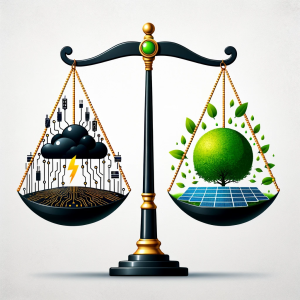In an era where artificial intelligence seamlessly integrates into our lives, from healthcare diagnostics to shopping, to art, its rapid advancement paints a future overflowing with possibilities. Yet, beneath this promising facade lies a complex, often-overlooked challenge: the sustainability of AI. Without clear rules and regulations, AI can be easily abused, leading to negative consequences that extend far beyond the technological industry. In a world driven by profit, environmental considerations are often sidelined, especially in the fiercely competitive landscape of AI development. Moreover, there exists a significant knowledge gap among the general public regarding AI. Many are unaware of how AI systems operate and the potential for unsustainable practices in their development and deployment. This lack of understanding means that issues of AI abuse and environmental impact can go unnoticed or unaddressed by those it affects most.

We must ask ourselves: Are we doing enough to ensure that AI progresses in a manner that is not only innovative and beneficial but also sustainable and ethically sound? Comprehensive government regulations are essential to ensuring that AI advances in a way that benefits all, rather than leading to abuse and environmental degradation.
AI Abuse Defined
Firstly, it’s important to understand AI abuse in the context of environmental sustainability, as it is a critical issue, often overshadowed in the discourse on artificial intelligence. AI abuse, in this sense, refers to practices that significantly harm our environment, often as a result of inadequate regulatory frameworks or lack of knowledge about the implications of AI usage. A prominent form of this abuse is the excessive energy consumption of AI systems, often intertwined with profit-driven motives where environmental considerations are disregarded.
Energy Consumption and Environmental Impact
AI systems, particularly large-scale ones used in data analysis and complex learning models, consume a lot of energy. The main source of this energy demand comes from data centers that power AI, many of which still rely on fossil fuels, contributing to greenhouse gas emissions and climate change. For instance, training advanced AI models, such as deep neural networks, can generate as much carbon dioxide as five average cars over their entire lifetimes [1]. Besides energy consumption, the production, use, and disposal of AI hardware also have significant environmental costs, including the extraction of rare earth elements and the generation of electronic waste [2].
Did you know how much water AI consumes?
“The global AI demand may even require 4.2 – 6.6 billion cubic meters of water withdrawal in 2027, which is more than the total annual water withdrawal of 4 – 6 Denmark or half of the United Kingdom.“
Shaolei Ren, Associate Professor of Electrical and Computer Engineering, University of California, Riverside https://oecd.ai/en/wonk/how-much-water-does-ai-consume
Some believe that the solution lies in taxing or fining companies for their excessive energy and resource use. However, the reality is that many tech companies are so financially robust that these penalties barely make a dent in their finances. They continue to generate enormous profits, which makes these fines a minor inconvenience rather than a genuine deterrent. This situation highlights the need for more effective regulations that go beyond financial penalties. Such regulations could mandate the use of renewable energy sources in data centres and enforce sustainable supply chain regulations. Additionally, the government could promote the development of environmentally friendly hardware, thereby reducing AI’s direct environmental impact, meanwhile penalising companies by restricting the sale of inefficient GPUs.
Innovation Race vs Environment

Environmental abuse is also strongly present in fierce competition to achieve AI superiority, both at corporate and national levels, often leading to significant neglect of environmental concerns. This race for technological dominance prioritizes rapid innovation and market leadership, sometimes at the cost of ethical and ecological responsibility. Companies and countries, in their pursuit to outdo each other in AI advancements, may resort to corner-cutting practices that compromise environmental sustainability. The pressure to deliver groundbreaking AI solutions quickly can lead to overlooking the energy-intensive nature of AI research and development.
For instance, the training of large-scale AI models, which is central to achieving breakthroughs in AI, requires enormous computational power, supported by higher energy consumption, with data centres running on non-renewable energy sources [3]. This continuous competition not only undermines global efforts to combat climate change but also sets a concerning precedent for future technological developments. By incorporating international standards of energy consumption within diplomatic frameworks, nations can collectively ensure that the pursuit of AI development aligns with global environmental health, fostering a sustainable technological future.
Why Are We Hesitant to Implement AI Regulations?
Critics could argue that heavy regulations could decelerate innovation in the AI sector. They fear that strict rules might slow down the pace of technological advancements, making it harder for startups and established companies to innovate and compete on a global scale. However, properly designed regulations can actually foster innovation by reducing uncertainties and creating a level playing field. Furthermore, there are numerous instances where regulations have stimulated innovation rather than restrained it. For example, emissions standards have led to advancements in automotive technologies, including the development of electric vehicles and more efficient engines. Similarly, AI regulations could motivate companies to innovate in ways that are both technologically advanced and environmentally sustainable.
Lack of Public Awareness: Knowledge Gap
Lastly, another significant problem for sustainable AI is the knowledge gap that exists among the general public. Many people lack a comprehensive understanding of what AI is, how it operates, and the potential negative impacts it can have on society and the environment. A recent survey conducted by the Pew Research Center found that while many Americans are aware of common AI applications like customer service chatbots and product recommendations, only 30% could correctly identify all six uses of AI asked about in the survey [4]. This indicates the public has a very surface level understanding of AI. Additionally, an Ipsos survey for the World Economic Forum in 28 countries revealed that nearly two-thirds of adults expect AI to significantly change their daily lives in the next 3-5 years, highlighting that the public doesn’t understand how much of AI is already present in our daily lives [5].

This gap can lead to widespread misconceptions about AI, such as overestimating its capabilities or underestimating environmental issues associated with its development and use. For instance, the general public might not be aware of the substantial energy requirements of large-scale AI systems or the environmental cost of producing and disposing of AI hardware. This lack of awareness means that the demands for more sustainable AI practices are not as strong as they could be, allowing companies and governments to continue unsustainable practices without significant public pressure.
Closing this knowledge gap is essential and requires joint efforts in education and public awareness campaigns. These initiatives should aim to demystify AI, making information about its workings and impacts accessible and understandable to a broad audience. Education programs in schools, public service announcements, and informative media content can play a pivotal role in enhancing public understanding. Alongside these educational efforts, regulations for transparency and sustainability within AI companies will grant the general public easy access to the environmental data of their products, allowing the user to make choices that favour environmentally responsible AI practices and technologies.
Conclusion
The path to sustainable AI is filled with challenges from ethical, environmental, and educational standpoints. Government regulations emerge not just as a necessity but as a foundation for ensuring AI develops in a manner that is beneficial for our environment and society. By implementing comprehensive regulations, fostering public awareness, and prioritising environmental sustainability, we can harness the potential of AI to create a future that is not only innovative but also environmentally responsible. Before all these changes happen, you yourself can make a difference! Look into how much AI is actually present in your daily life and what do you know about it? Are all these hundreds of ChatGPT searches really necessary?


